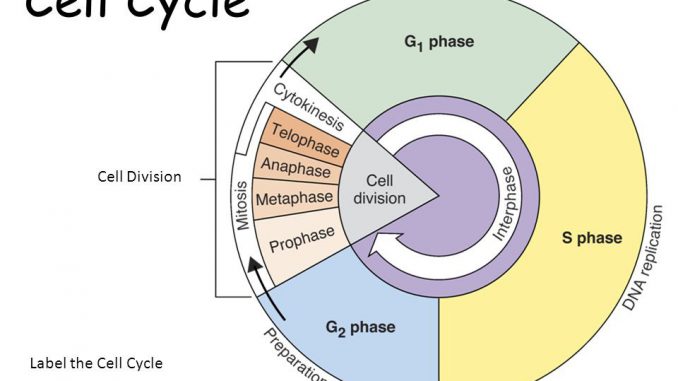
- In both unicellular and multicellular eukaryotes, the cell reproduction is a cyclic process of growth, nuclear division and usually cytoplasmic division called cell cycle.
- Cell cycle is a series of macro-molecular events that lead to cell division and the production of two daughter cells, each containing chromosomes identical with those of the parental cell.
- Two main molecular processes take place during the cell cycle are duplication of parental chromosome during S phase and separation of chromosome equally to daughter cell during M phase.
- In somatic cell, the cell cycle consists of following four phase;
- G1 (gap 1) phase
- S (synthesis) phase
- G2 (gap 2) phase
- M (mitosis) phase
1. G1 (gap1) phase:
- The first stage of interphase is called the G1 phase (first gap) because, from a microscopic aspect, little change is visible. However, during the G1 stage, the cell is quite active at the biochemical level.
- It is characterized by a change in chromosome from condensed state to more extended state and series of metabolic events that leads to initiation of DNA replication. During G1 phase, chromatin fibres become slender, less coiled and fully extended and more active for transcription. The transcription results in synthesis of RNAs (tRNA, mRNA and rRNA) ad series of proteins molecules required for initiation of DNA replication.
- The length of G1 phase varies from cell to cell and also the length of G1 phase is more than other three phase in cell cycle.
- G1 phase represents 25-40% of generation time of a cell.
- G1 phase is very significant phase of cell cycle as the cell grows and accumulates the building blocks of chromosomal DNA and the associated proteins as well as sufficient energy reserves to complete the task of replicating each chromosome.
- Within G1 phase there is a definite check point at which DNA synthesis is initiated and once the biochemical events associated with that point have occurred cell proceeds towards division.
2. S (synthesis) phase:
- The synthesis phase of interphase is biochemically a phase of active DNA synthesis and histone synthesis.
- In the S phase, chromosome numbers doubles which is accomplished by DNA replication and associated proteins. Although some of the histone protein synthesis occurs in G1 phase, most of it is synthesized during S phase.
- DNA replication is semi conservative and discontinuous type which results in the formation of identical pairs of DNA molecules.
- After doubling of chromosome, sister chromatids are still firmly attached to the centromeric region.
- At the center of each animal cell, the centrosomes of animal cells are associated with a pair of rod-like objects, the centrioles, which are at right angles to each other. Centrioles help organize cell division. Centrioles are absent in plants and most fungi.
- The centrosome (centriole) is also duplicated during the S phase. The two centrosomes will give rise to the mitotic spindle, the apparatus that mediate the movement of chromosomes during mitosis.
3. Gap2 (gap2) phase:
- G2 phase follows S phase. This phase represents 10-25% of generation time of cell.
- In G2 phase chromosome consists of two chromatids ie the cell has twice the amount of DNA content.
- In the G2 phase, the cell restore its energy stores and synthesizes proteins necessary for chromosome manipulation.
- Some cell organelles are duplicated, and the cytoskeleton is dismantled to provide resources for the mitotic phase.
- There may be additional cell growth during G2. The final preparations for the mitotic phase must be completed before the cell is able to enter the first stage of mitosis
4. M (mitotic) phase:
- M phase follows G2 phase. During this phase cell divides into two daughter cell with equal distribution of chromosome among daughter cells. After M phase cell enter into G1 phase and next cell cycle is repeated. However, some cell after completion of mitosis do not enter into G1 phase, those cell are referred as G0 cells.
- M phase consists of following sub –phases;
- During prophase, the nuclear membrane disappears, spindle fibers form, and DNA condenses into chromosomes (sister chromatids ).
- During metaphase, the sister chromatids align along the equator of the cell by attaching their centromeres to the spindle fibers.
- During anaphase, sister chromatids are separated at the centromere and are pulled towards opposite poles of the cell by the mitotic spindle.
- During telophase, chromosomes arrive at opposite poles and unwind into thin strands of DNA, the spindle fibers disappear, and the nuclear membrane reappears.
- Cytokinesis is the actual splitting of the cell membrane; animal cells pinch apart, while plant cells form a cell plate that becomes the new cell wall.
- Cells enter the G0 (inactive) phase after they exit the cell cycle when they are not actively preparing to divide; some cells remain in G0 phase permanently.
